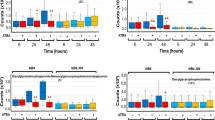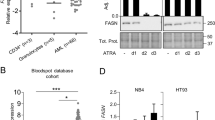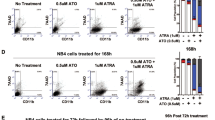Abstract
All-trans retinoic acid (ATRA) significantly improves the survival of patients with acute promyelocytic leukemia (APL) by inducing granulocytic differentiation of leukemia cells. Since an activation of the transcription factor NF-κB occurs during ATRA-induced maturation of APL cells, a mechanistic link between these two processes was investigated. Using an in vitro model for APL, we report that ectopic overexpression of a repressor of NF-κB activation did not affect granulocytic differentiation. Importantly, NF-κB inhibition markedly resulted in a decreased viability of the differentiated cells, which correlated with increased apoptosis. Apoptosis was accompanied by a sustained activation of the c-Jun N-terminal kinase (JNK). Inhibition of JNK by the specific inhibitor SP600125 or by transfection of a dominant-negative mutant of JNK1 reduced the percentage of apoptotic cells, thus showing that JNK activation constitutes a death signal. Furthermore, impairment of NF-κB activation resulted in increased levels of reactive oxygen species (ROS) upon ATRA treatment. ROS accumulation was suppressed by the antioxidant butylated hydroxyanisol, which also abolished ATRA-induced JNK activation and apoptosis. Altogether, our results demonstrate an antiapoptotic effect of NF-κB activation during ATRA-induced differentiation of NB4 cells and identify repression of ROS-mediated JNK activation as a mechanism for this effect. Our observations also suggest that NF-κB signalling may contribute to an accumulation of mature APL cells and participate in the development of ATRA syndrome.
This is a preview of subscription content, access via your institution
Access options
Subscribe to this journal
Receive 50 print issues and online access
$259.00 per year
only $5.18 per issue
Buy this article
- Purchase on Springer Link
- Instant access to full article PDF
Prices may be subject to local taxes which are calculated during checkout







Similar content being viewed by others
References
Adcock IM . (2001). Pulm. Pharmacol. Ther., 14, 211–219.
Adler V, Yin Z, Tew KD and Ronai Z . (1999). Oncogene, 18, 6104–6111.
Akgul C and Edwards SW . (2003). Cell Mol Life Sci., 60, 2402–2408.
Altucci L, Rossin A, Raffelsberger W, Reitmair A, Chomienne C and Gronemeyer H . (2001). Nat. Med., 7, 680–686.
Atfi A, Buisine M, Mazars A and Gespach C . (1997). J. Biol. Chem., 272, 24731–24734.
Bell S, Degitz K, Quirling M, Jilg N, Page S and Brand K . (2003). Cell Signal., 15, 1–7.
Benoit GR, Flexor M, Besancon F, Altucci L, Rossin A, Hillion J, Balajthy Z, Legres L, Segal-Bendirdjian E, Gronemeyer H and Lanotte M . (2001). Mol. Endocrinol., 15, 1154–1169.
Bernard D, Monte D, Vandenbunder B and Abbadie C . (2002). Oncogene, 21, 4392–4402.
Berry DM, Clark C S and Meckling-Gill KA . (2002). Exp. Cell Res., 272, 176–184.
Besançon F, Atfi A, Gespach C, Cayre YE and Bourgeade MF . (1998). Proc. Natl. Acad. Sci. USA, 95, 8081–8086.
Bonizzi G and Karin M . (2004). Trends Immunol., 25, 280–288.
Brouard S, Berberat PO, Tobiasch E, Seldon MP, Bach FH and Soares MP . (2002). J. Biol. Chem., 277, 17950–17961.
Buccellato LJ, Tso M, Akinci OI, Chandel NS and Budinger GR . (2004). J. Biol. Chem., 279, 6753–6760.
Cai Z, Korner M, Tarantino N and Chouaib S . (1997). J. Biol. Chem., 272, 96–101.
Chambon P . (1996). FASEB J., 10, 940–954.
Chen F, Castranova V and Shi X . (2001). Am J Pathol., 159, 387–397.
Chen F, Castranova V, Li Z, Karin M and Shi X . (2003). Cancer Res., 63, 7689–7693.
Chomienne C, Fenaux P and Degos L . (1996). FASEB J., 10, 1025–1030.
Clark RA . (1990). J. Infect. Dis., 161, 1140–1147.
Davis RJ . (2000). Cell, 103, 239–252.
De Botton S, Dombret H, Sanz M, Miguel JS, Caillot D, Zittoun R, Gardembas M, Stamatoulas A, Conde E, Guerci A, Gardin C, Geiser K, Makhoul DC, Reman O, de la Serna J, Lefrere F, Chomienne C, Chastang C, Degos L and Fenaux P . (1998). Blood, 92, 2712–2718.
De Smaele E, Zazzeroni F, Papa S, Nguyen DU, Jin R, Jones J, Cong R and Franzoso G . (2001). Nature, 414, 308–313.
De Thé H, Lavau C, Marchio A, Chomienne C, Degos L and Dejean A . (1991). Cell, 66, 675–684.
De Thé H and Chelbi-Alix MK . (2001). Oncogene, 20, 7136–7139.
Djavaheri-Mergny M, Wietzerbin J and Besançon F . (2003). Oncogene, 22, 2558–2567.
Djavaheri-Mergny M, Javelaud D, Wietzerbin J and Besançon F . (2004). FEBS Lett., 578, 111–115.
Gebauer F and Hentze MW . (2004). Nat. Rev. Mol. Cell. Biol., 5, 827–835.
Green DR and Reed JC . (1998). Science, 281, 1309–1312.
Grolleau A, Sonenberg N, Wietzerbin J and Beretta L . (1999). J. Immunol., 162, 3491–3497.
Hamasaki A, Sendo F, Nakayama K, Ishida N, Negishi I, Nakayama K and Hatakeyama S . (1998). J Exp Med., 188, 1985–1992.
Han Y, Weinman S, Bolgogh I, Walker RK and Brasier AR . (1999). J. Biol. Chem., 274, 787–794.
Huang ME, Ye YC, Chen SR, Chai JR, Lu JX, Zhoa L, Gu LJ and Wang ZY . (1988). Blood, 72, 567–572.
Hayden MS and Ghosh S . (2004). Genes Dev., 18, 2195–2224.
Iotsova V, Caamano J, Loy J, Yang Y, Lewin A and Bravo R . (1997). Nat Med., 3, 1285–1289.
Iwanaga M, Mori K, Iida T, Urata Y, Matsuo T, Yasunaga A, Shibata S and Kondo T . (1998). Free. Radic. Biol. Med., 24, 1256–1268.
Javelaud D, Wietzerbin J, Delattre O and Besançon F . (2000). Oncogene, 19, 61–68.
Javelaud D and Besançon F . (2001). Oncogene, 20, 4365–4372.
Kamata H, Honda S, Maeda S, Chang L, Hirata H and Karin M . (2005). Cell, 120, 649–661.
Karin M and Lin A . (2002). Nat. Immunol., 3, 221–227.
Komura E, Tonetti C, Penard-Lacronique V, Chagraoui H, Lacout C, LeCouedic JP, Rameau P, Debili N, Vainchenker W and Giraudier S . (2005). Cancer Res., 65, 3281–3289.
Kouba DJ, Nakano H, Nishiyama T, Kang J, Uitto J and Mauviel A . (2001). J. Biol. Chem., 276, 6214–6224.
Kucharczak J, Simmons MJ, Fan Y and Gelinas C . (2003). Oncogene, 22, 8961–8982.
Larson RS and Tallman MS . (2003). Best Pract. Res. Clin. Haematol., 16, 453–461.
Lanotte M, Martin-Thouvenin V, Najman S, Balerini P, Valensi F and Berger R . (1991). Blood, 77, 1080–1086.
Lin A and Dibling B . (2002). Aging Cell., 1, 112–116.
Matsuzawa A, Nishitoh H, Tobiume K, Takeda K and Ichijo H . (2002). Antioxid. Redox. Signal., 4, 415–425.
Miyamoto S, Seufzer BJ and Shumway SD . (1998). Mol. Cell. Biol., 18, 19–29.
Nicholson RC, Mader S, Nagpal S, Leid M, Rochette-Egly C and Chambon P . (1990). EMBO J., 9, 4443–4454.
Nickols JC, Valentine W, Kanwal S and Carter BD . (2003). Nat. Neurosci., 6, 161–167.
Orlowski RZ and Baldwin Jr AS . (2002). Trends Mol. Med., 8, 385–389.
Papa S, Zazzeroni F, Pham CG, Bubici C and Franzoso G . (2004). J. Cell Sci., 117, 5197–5208.
Pham CG, Bubici C, Zazzeroni F, Papa S, Jones J, Alvarez K, Jayawardena S, De Smaele E, Cong R, Beaumont C, Torti FM, Torti SV and Franzoso G . (2004). Cell, 119, 529–542.
Pianetti S, Arsura M, Romieu-Mourez R, Coffey RJ and Sonenshein GE . (2001). Oncogene, 20, 1287–1299.
Puccetti E and Ruthardt M . (2004). Leukemia, 18, 1169–1175.
Sakon S, Xue X, Takekawa M, Sasazuki T, Okazaki T, Kojima Y, Piao JH, Yagita H, Okumura K, Doi T and Nakano H . (2003). EMBO J., 22, 3898–3909.
Slack JL and Gallagher RE . (1999). Cancer Treat. Res., 99, 75–124.
Tallman MS, Andersen JW, Schiffer CA, Appelbaum FR, Feusner JH, Ogden A, Shepherd L, Rowe JM, Francois C, Larson RS and Wiernik PH . (2000). Blood, 95, 90–95.
Tang G, Minemoto Y, Dibling B, Purcell NH, Li Z, Karin M and Lin A . (2001). Nature, 414, 313–317.
Traenckner EB, Pahl HL, Henkel T, Schmidt KN, Wilk S and Bauerle PA . (1995). EMBO J., 14, 2876–2883.
Turco MC, Romano MF, Petrella A, Bisogni R, Tassone P and Venuta S . (2004). Leukemia, 18, 11–17.
Wang KK, Nath R, Posner A, Raser KJ, Buroker-Kilgore M, Hajimohammadreza I, Probert Jr AW, Marcoux FW, Ye Q, Takano E, Hatanaka M, Maki M, Caner H, Collins JL, Fergus A, Lee KS, Lunney EA, Hays SJ and Yuen P . (1996). Proc. Natl. Acad. Sci. USA, 93, 6687–6692.
Waris G, Livolsi A, Imbert V, Peyron JF and Siddiqui A . (2003). J. Biol. Chem., 278, 40778–40787.
Witcher M, Ross DT, Rousseau C, Deluca L and Miller Jr WH . (2003). Blood, 102, 237–245.
Xia Z, Dickens M, Raingeaud J, Davis RJ and Greenberg ME . (1995). Science, 270, 1326–1331.
Acknowledgements
This work was supported by INSERM and by grants from the Ligue Nationale contre le Cancer and the Association pour la Recherche sur le Cancer.
Author information
Authors and Affiliations
Corresponding author
Rights and permissions
About this article
Cite this article
Mathieu, J., Giraudier, S., Lanotte, M. et al. Retinoid-induced activation of NF-κB in APL cells is not essential for granulocytic differentiation, but prolongs the life span of mature cells. Oncogene 24, 7145–7155 (2005). https://doi.org/10.1038/sj.onc.1208889
Received:
Revised:
Accepted:
Published:
Issue Date:
DOI: https://doi.org/10.1038/sj.onc.1208889
Keywords
This article is cited by
-
Regulation of NF-κB by PML and PML-RARα
Scientific Reports (2017)
-
Analysis of the interplay between all-trans retinoic acid and histone deacetylase inhibitors in leukemic cells
Archives of Toxicology (2017)
-
A PARP-1/JNK1 cascade participates in the synergistic apoptotic effect of TNFα and all-trans retinoic acid in APL cells
Oncogene (2008)
-
MicroRNA gene expression during retinoic acid-induced differentiation of human acute promyelocytic leukemia
Oncogene (2007)



